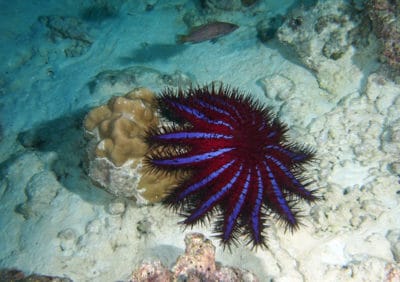Expedition Log: Maldives – Day 7
One of the most challenging questions we are regularly asked is where the crown of thorns starfish (COTS) come from. A reef can be unaffected for years or even decades and then suddenly thousands of animals emerge from the depths, moving through the reef system in a swarm as they consume nearly every coral in their path.
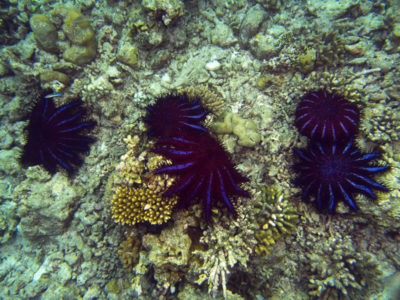
Swarm of COTS in the shallows.
There are several theories that explain the occurrence of an outbreak. One thought is that their predators may have declined due to overfishing and collection. For instance, shell collectors often take trumpet triton snails (Charonia tritonis) and helmet snails (Cassis spp.) to sell to tourists. Certain predatory fish such as a puffer fish (Arothron hispidus), trigger fish (Balistoides viridescens, Pseudobalistes flavimarginatus), and napoleon wrasse (Cheilinus undulatus) will feed on juveniles and small adults.
A more likely explanation is related to larval survival. COTS are known as broadcast spawners, meaning the males and females release clouds of eggs and sperm into the water column, which are then fertilized and develop into free-swimming larvae. These can spend several weeks as part of the plankton until they find a suitable reef to settle onto.
COTS usually spawn at specific times of year, with individual females releasing as many as 50 million eggs at one time. Normally, very few of these survive and metamorphose into coral-eating starfish. Certain conditions can promote much higher survival though. In areas with higher levels of nutrients – such as high islands with a lot of agriculture, populated coastlines with sewage discharge and runoff, and even places where nutrients upwell from deep water – there may be plankton blooms which provide more food for the COTS larvae. Ultimately higher survival of the larvae, greater numbers will settle onto the reef, and six months to two years later these will emerge from their hiding places and begin eating coral.
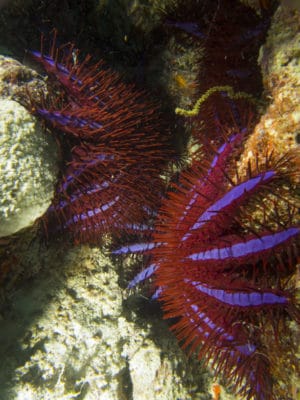
Two COTS emerge from a crevice where they have been hiding.
Once they emerge, higher densities will be concentrated wherever there are large stands of their preferred corals, especially areas with table acroporids and thickets of bush-like and branching acroporids. Over time, as their food becomes scarce, the numbers of COTS in one area decline, but individuals or small aggregations will continue to be seen. At this point, they tend to begin to feed on less preferred species, such as the slow-growing massive corals (e.g. Porites). Several months to years after an outbreak it is very common to see a graveyard of dead branching, plating and table acroporids, all covered in turf algae, and numerous fresh lesions on the remaining massive corals.
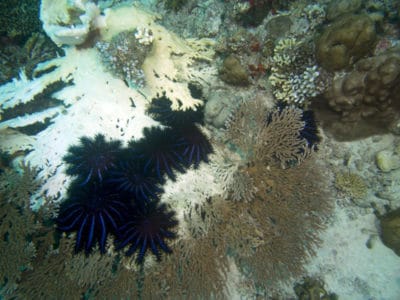
Large group of COTS on a table acroporid.
After four days, we were able to remove the majority of COTS from the entire stretch of the linear reef system that extends from Gili Lankanfushi past Himmafushi. We also identified a possible origin of the outbreak and the patterns of spread. Our lines of evidence include the current distribution of the starfish, patterns of mortality of affected corals, identification of areas both upstream and downstream that have not been affected by COTS, and a possible source of nutrients that may have fueled higher survival of the larvae.
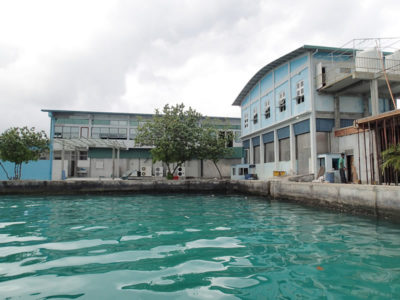
Tuna processing plant at Himmafushi… one of the possible crown of thorns starfish sources here in the Maldives.
Himmafushi is a densely populated island with over 5000 people living within an area of about 4.5 sq km. There is also a tuna processing plant located on the shoreline, adjacent to a channel that cuts through the reef system. From 5-20 m at the mouth of the channel are piles of tuna discards. This site also had unusually large schools of plankton-feeding fish and other species, as well as higher cover of algae on the reef – both indicators of a nutrient source. The corals surrounding the channel also appear to be the first ones that were killed by COTS, and the center of the outbreak was located a few km north of this site. Further, the affected community shifts from mostly dead massive and branching corals (skeletons covered in algae) and few remaining COTS near the channel, to a mix of live, old dead (algal covered skeletons) and recently dead corals (white skeletons) north and south of the channel. At the perimeter of the outbreak, there are many more live corals, and all corals eaten by COTS still had stark white skeletons without algal colonization, suggesting they were eaten within the last week or so.
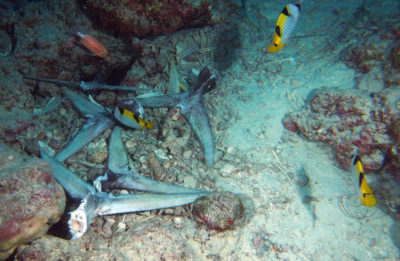
Tuna waste from the processing plant at densely-populated Himmafushi.
While it is possible that the larvae originated from elsewhere and were carried by water currents to this spot, the starfish do appear to have begun their rampage through the reef near the channel and were quickly destroying the reef system as they spread north and south. Fortunately, our scientists with the SCAR Program were able to control the outbreak before the reef system was lost.
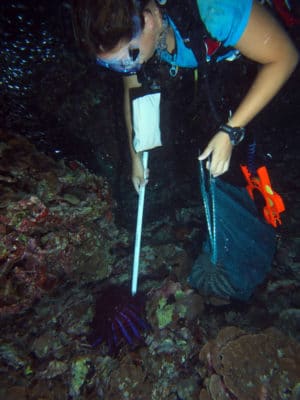
Georgia collecting COTS at Himmafushi on Turbinaria.
Photos by Andrew Bruckner.
